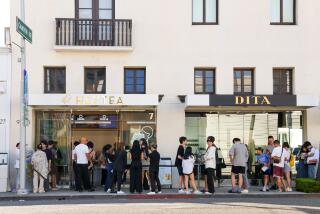Slurp, Slurp
Which has less color, Mao tea or white tea?
If you say white tea, you’re wrong. The correct answer is Mao tea, which is a cup of plain boiled water. That is a joking description of what people drank in China when good tea was reserved for export.
White tea does exist. It’s a Chinese tea brewed from lightly processed buds of the tea plant. The color is light, the flavor is delicate and the price can run as high as $200 a pound.
Rare teas such as this were talked about and tasted last weekend at a conference of the American Premium Tea Institute in Long Beach. The white tea poured was, to be sure, a less expensive brand, costing a mere $8 a pound. Still, white teas are so new to the West that it’s a privilege to taste any of them. This one was Lung Ching (Dragon’s Well), named in honor of a dragon that legend says provided rain to save crops in Hangzhou, China.
“It’s a friendly tea, not a striking tea,” explained Michael J. Spillane, president and owner of G.S. Haly Co., a tea import and brokerage firm, who led the tasting. “What you should appreciate is that when you taste it, you don’t taste any water.”
Now that’s a neat trick, brewing a tea with almost no flavor that doesn’t taste like water, especially since the Long Beach water contains enough chlorine to give a “soapy” nuance. (The best water for tea-brewing is apparently in Seattle and Manhattan.) Furthermore, the tea was dispensed from air pots, the kind normally used for dispensing coffee to large groups, into paper cups, not the fine China cups that should be used for tea drinking.
To taste tea, you must slurp it loudly, because tea needs oxygen to release its flavor. “Can we make some noise?” Spillane urged those who were drinking too politely. “You need to spray your entire mouth and draw air in with the tea to get a proper taste.”
Slurping also makes it possible to drink very hot liquid without burning the mouth, and tea is at its best when hot. As it cools, it loses flavor.
Tea connoisseurship has its own lingo, and conference speakers talked about dust (fine particles), fannings (slightly larger particles), broken orange pekoe (still larger) and orange pekoe (whole leaf teas). Pekoe is not a kind of tea. And they didn’t say PEE-koh as most of us do, but PECK-oh.
Until World War II, Americans drank primarily green (unfermented) and oolong (semi-fermented teas). Green tea is what the colonists dumped into the harbor during the Boston Tea Party. Black (fermented) tea caught on only after the war.
Terms such as “first flush,” “second flush” and “autumnal flush” indicate when the teas were plucked. And TGFOP is not just alphabet soup; it’s shorthand for “tippy golden flowery orange pekoe.” It means whole-leaf tea that includes a fair share of whole golden leaf buds.
Like wine, tea can inspire such odd descriptions as earthy, tarry, roasty and, as in the case of our chlorine-spiked Long Beach tea, soapy. “If you smell a tea that smells like your barbecue pit, chances are it’s a Lapsang,” Spillane said. The blend called Russian caravan usually contains Lapsang souchong leaves to add the distinctive taste that tea shipped long ago via camel to Russia acquired from smoky campfires.
A brisk eye-opener was no doubt essential on those long journeys. Today, though, it’s become trendy to cut out caffeine. A sneaky way to do this and avoid buying expensive decaffeinated products is to pour hot water over tea leaves, let them stand one minute, then drain. The tea will lose some of its flavor--and 85% of its caffeine.
If you want to settle that argument about which contains more caffeine, tea or coffee, the answer is: tea, sort of. Pound for pound, dry tea contains more caffeine than coffee. It’s the brewing that makes the difference. One pound of coffee yields 40 to 50 cups, but the same amount of tea yields 175 cups--more if you are thrifty and make it really weak.
More to Read
Eat your way across L.A.
Get our weekly Tasting Notes newsletter for reviews, news and more.
You may occasionally receive promotional content from the Los Angeles Times.







